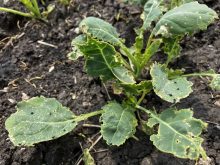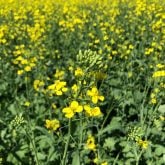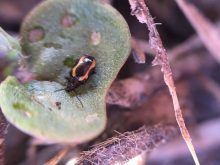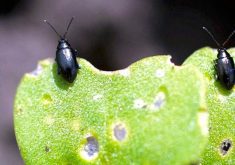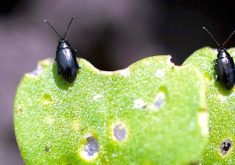After the harvest from hell last fall Manitoba farmers are struggling with spring seeding setbacks.
As of June 4 the Manitoba Agricultural Service Corporation (MASC) had received more than 480 reseeding claims representing 130,000 acres, due to perils including frost, flea beetles, crusted soils and hot, dry winds, or a combination of some or all, MASC’s sales manager David Koroscil said in an interview June 4.
“Since the weekend it has been mostly wind and flea beetles,” he said.
Why it matters: The numbers highlight what a tough fall and spring the province’s farmers have been through.
Read Also

CUSMA access key among other trade noise: Seeds Canada panel
Seeds Canada conference panelists say Canada needs to stay focused and wait as U.S. trade and tariff chaos develops, and a Canada-U.S.-Mexico Agreement review looms
Most of the reseeding claims so far are for canola, Koroscil said.
Around 70 of the claims are for winterkilled fall rye and winter wheat, he said.
Many of the claims came through MASC’s Headingley office due to a combination of factors, Koroscil said. Crusted soil is one. It’s the result of heavy rains May 23, especially in the Elie-Marquette area, he said.
Flea beetles and dry, hot winds have added more stress to struggling seedlings.
Dust was in the air in many parts of south-central Manitoba, including the Carman-Graysville area June 2 and 4, as high winds started moving soil off some fields, despite crop being up.
While frost struck much of agro-Manitoba May 30, because of the delayed spring there was less emerged canola to damage, Koroscil said.
While 480 reseeding claims are up from 321 as of May 31, 2019, there were 509 claims as of May 31, 2018, he said.
However, as of June 14, 2019 MASC had 1,359 reseeding claims, mostly due to flea beetles, Koroscil said.

The spring of 2019 was also cool, he said. As a result, canola emergence was delayed and the seed treatment intended to ward off flea beetles provided protection for a shorter time.
The reseeding benefit under crop insurance is 25 per cent of the per-acre dollar coverage for that crop, Koroscil said.
While there was some annual crop and alfalfa damaged by frost May 30 in most cases it was light, Anastasia Kubinec, Manitoba Agriculture and Resource Development’s (MARD) manager of crop industry development, said in an interview June 1.
But she warned many crops were at risk to flea beetles, cutworms, high winds and crusted soil.
Most of MARD’s weather stations were no colder than -2 C, for one to four hours May 30 (see map).
There were exceptions though including -4.4 C for five hours at Sprague Lake, and -4.2 C and -3.7 C for seven hours at Marchand and Narcisse.
Jason Voogt of Field 2 Field Agronomy was seeing frost-damaged canola in the Carman and Elm Creek areas Monday morning (June 1), but not enough to warrant reseeding, he said in an interview.
Some corn leaves were singed as well, but the plants will survive, he said.
Like Kubinec, Voogt said farmers should be checking fields for flea beetles and cutworms.
“We are really starting to notice more flea beetle activity since the heat came around last week,” he said in an interview June 1.
“It’s not general, but we are seeing a number of fields around Carman, Elm Creek and out to Starbuck getting sprayed for flea beetles. In some cases it’s whole fields and in some cases borders, but what we’re noticing in just a day or two a field can go from looking just perfect to having quite a bit of feeding going on so we’re continuing to monitor.”
Voogt tweeted that frost damage could attract even more flea beetles because it releases a pheromone called allyl-isothiocyanate.
“Highly concentrated, it smells like horseradish,” he wrote. “Not that canola needed a cologne or anything to attract flea beetles, just sayin’(sic).”
Neonicotinoid canola seed treatments such as Helix and Prosper provide three to four weeks of protection against flea beetle feeding from the time of planting, MARD entomologist John Gavloski said in an interview June 1.
“For people who seeded into warm soil with good moisture those seed treatments might be all they need,” he said. “The problem is any canola, because of stressful conditions, sits in that seedling stage for more than three weeks you have to be scouting for flea beetles because they are another potential threat. If frost or dry conditions or basically any stress sets it back and keeps it in that seedling stage for a prolonged period that just makes it more susceptible to flea beetle feeding. I know there already have been a few fields sprayed for flea beetles.”
Thanks to warmer temperature forecast this week, canola fields with good moisture could soon grow less susceptible to flea beetle, Gavloski said.
Cutworms are showing up in some fields and some fields have been sprayed, he said.
Neonic canola seed treatments don’t control cutworms very well, he added. However, Lumiderm and Fortenza Advanced, two other canola seed treatments, do.
Lumivia is a cutworm seed treatment available in cereal crops and pea; Fortenza Advanced is also registered for corn, Gavloski said.
“Last year was a fairly bad cutworm year so this year there is probably going to be more people using these seed treatment products for cutworms,” he said.
Wilting sunflowers could be because of cutworms and not frost, Kubinec said.
“A picture I saw showed one (sunflower) wilted and one perfectly fine,” she said. “That’s a giveaway that it’s not necessarily frost because you have two plants side by side and one is fine and one is not, so something else is going on.”
Voogt is seeing some reseeding in the Fannystelle-Starbuck area due to hard-packed soils affecting emergence following a heavy rain May 23.
“A lot of producers were thinking because seeding was delayed maybe we missed the insects but it’s not the case because they emerge based on growing degree days so everything has just shifted, including the insects,” he said.








